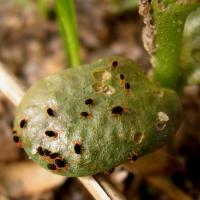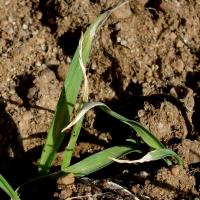Diagnosing redlegged earth mite
Redlegged earth mite (RLEM) is a sap-sucking pest of crops and pastures. Canola and peas are particularly susceptible. They often co-exist with blue oat mites.
What to look for
- Adults are 1 millimetre (mm) long with a black body and eight red-orange legs.
- Newly hatched mites are 0.2 mm long with a pinkish-orange body and 6 legs.
Insect Adult
- Feeding causes a silver or white discolouration of leaves and distortion. If damage is severe plants shrivel and die.
- Damage is more severe when seedlings are stressed (e.g. cold waterlogged or very dry conditions).
Plant
What else could it be
| Condition | Similarities | Differences |
|---|---|---|
| Diagnosing blue oat mite | Similar plant damage | Blue oat mite has a red dot on its back |
| Diagnosing balaustium mite | Plant damage and the immature Balaustium mite is the same size | Balaustium mite adult is twice the size of a RLEM |
| Diagnosing bryobia mite | Similar plant damage | The bryobia mite's front leg are much larger than the rest, and it makes whitish trails of spots on the leaf surface |
Where did it come from?

Green bridge
- RLEM comes from South Africa, and usually have 3 generations per season with the last generation producing thick walled over-summering eggs in spring.
- Oversummering eggs hatch in autumn, stimulated by adequate moisture and at least 7 days of temperatures below 20°C.
- Mite damage tends to be worse after pastures than cereal crops.
Management strategies

Seed dressing insecticide

Green bridge control

Spraying insecticide

Rotation
- Spray only if you need to. RLEM have been detected that have resistance to synthetic pyrethroids. Rotate chemical groups in and between seasons, as this will help to reduce resistance occurring.
- Use insecticide seed treatments for crops and new pastures with moderate pest pressure rather than spraying whole paddocks. This allows for smaller quantities of pesticide to be used that will directly target plant feeding pests.
- Control weeds before seeding, particularly in late autumn or winter sown crops where RLEM are likely to hatch before seeding. At least one week of bare soil can "starve out" most of the mite population before crops are sown.
- Control weeds in the crop and along fencelines that provide habitat for mites. A weed free crop will have few mites and over-summering eggs to carry through to the following season.
- Controlled grazing of pasture paddocks that will be cropped next year will reduce mite numbers to levels that are almost as effective as chemical sprays. Sustained grazing of pastures throughout spring to maintain them at levels below 2 tonnes per hectare. Feed On Offer (FOO) (dry weight) will restrict mite numbers to low levels.
- Apply insecticides to paddocks that are to be cropped during spring to prevent RLEM populations producing over-summering eggs. This will minimise the pest population for the following autumn. TIMERITE® is a free package that provides a date in spring for a spray application to stop female RLEM from producing over-summering eggs.
- Look at your cropping rotations to decrease reliance on pesticides. The risk is generally highest if paddocks have been in long term pasture (with high levels of broad-leafed plants) where mite populations have been uncontrolled. Lower risk paddocks that generally do not require mite control are often those which follow a weed free cereal or chickpea crop.
Economic and financial considerations
To assist in assessing the economic risk and financial costs associated with various treatment strategies go to MyEconomicTool
There may be other economic and financial implications that need to be considered when choosing a management option. These may include:
Pre-crop- Understand the potential yield losses associated with earth mite feeding damage.
- Assess the costs and benefits of taking various preventative actions in the spring period in the year prior.
- Assess the cost and benefits of taking preventative action immediately prior or at seeding.
- Compare the costs, benefits and risk of each management option against doing nothing.
- Consider risk and associated costs or savings of no treatment or delaying treatment.
- Ignore all previous treatment costs when assessing current management options.
- Undertake a “what if” scenario analysis to see what impact changing variables (e.g. grain price and season conditions), have on the likely economic outcome.
- Include a resistance management strategy into your spray program to reduce the chance of earth mites and other non-target pests developing resistance.
View these economic considerations in more detail.
How can it be monitored?
- Check paddock for mites in the spring and again before seeding.
- Check for mites on the ground and leaves and for plant damage from emergence to to early vegetative stage, particularly in late sown crops.
See also
Further information
Page last updated: Thursday, 16 December 2021 - 10:50am





